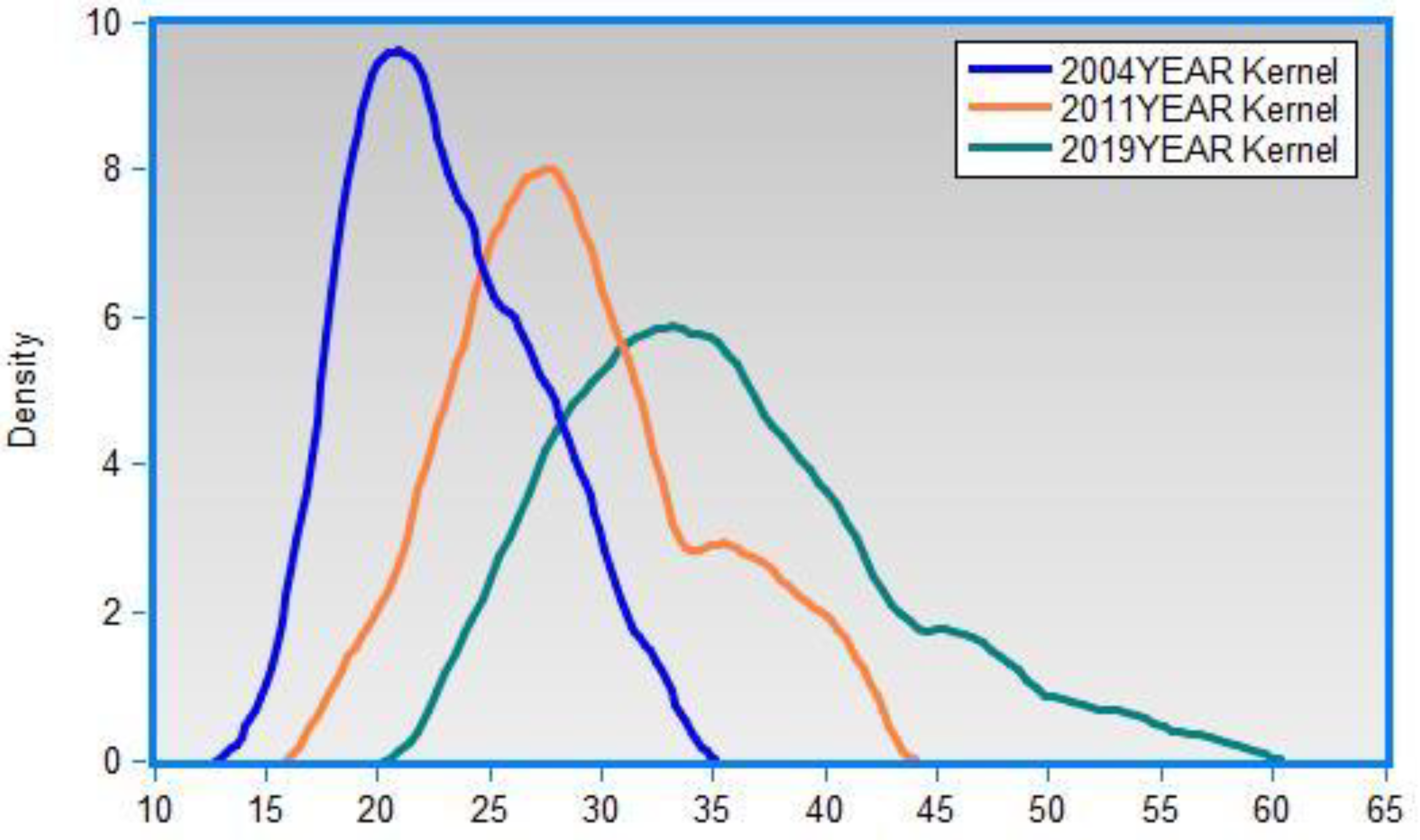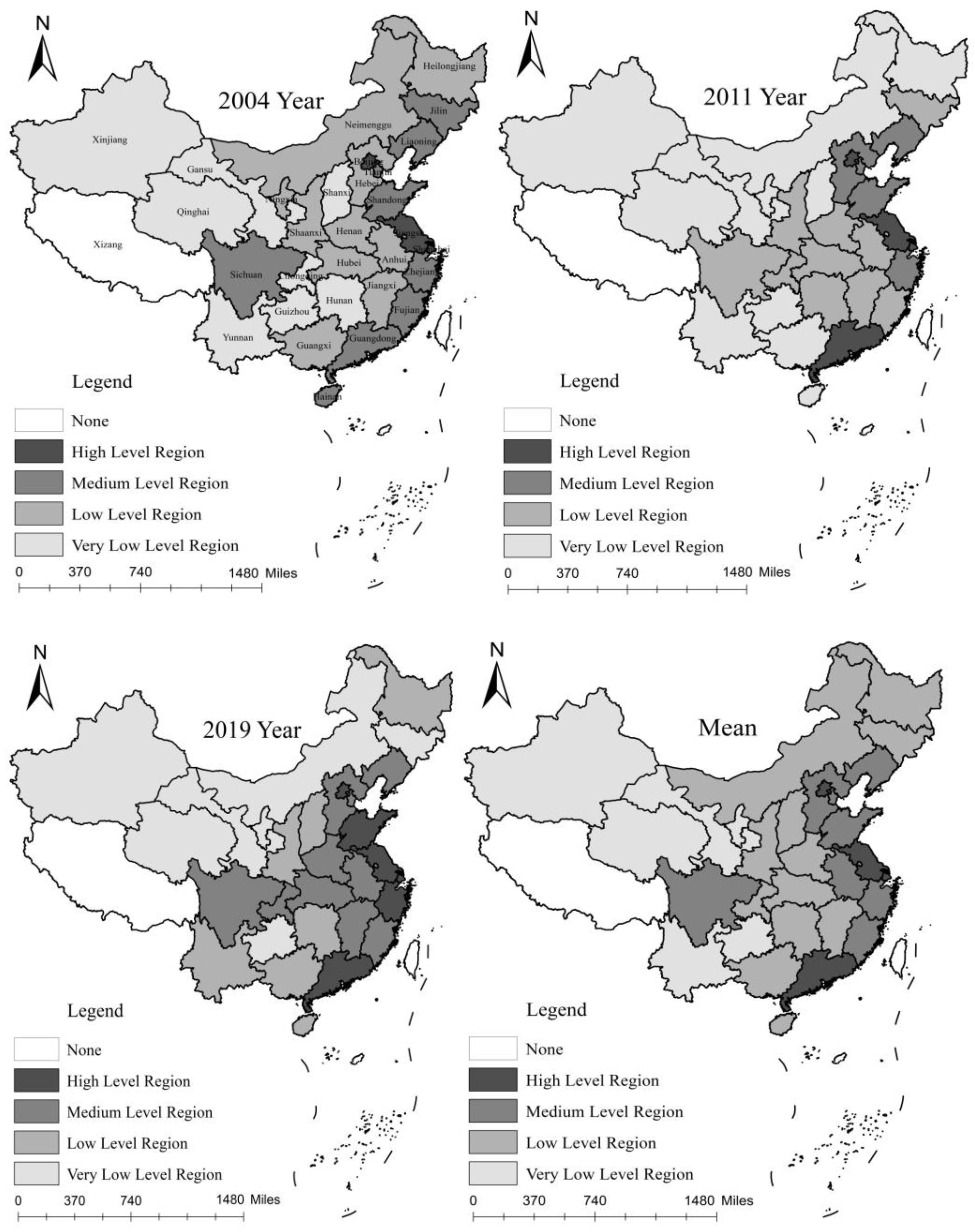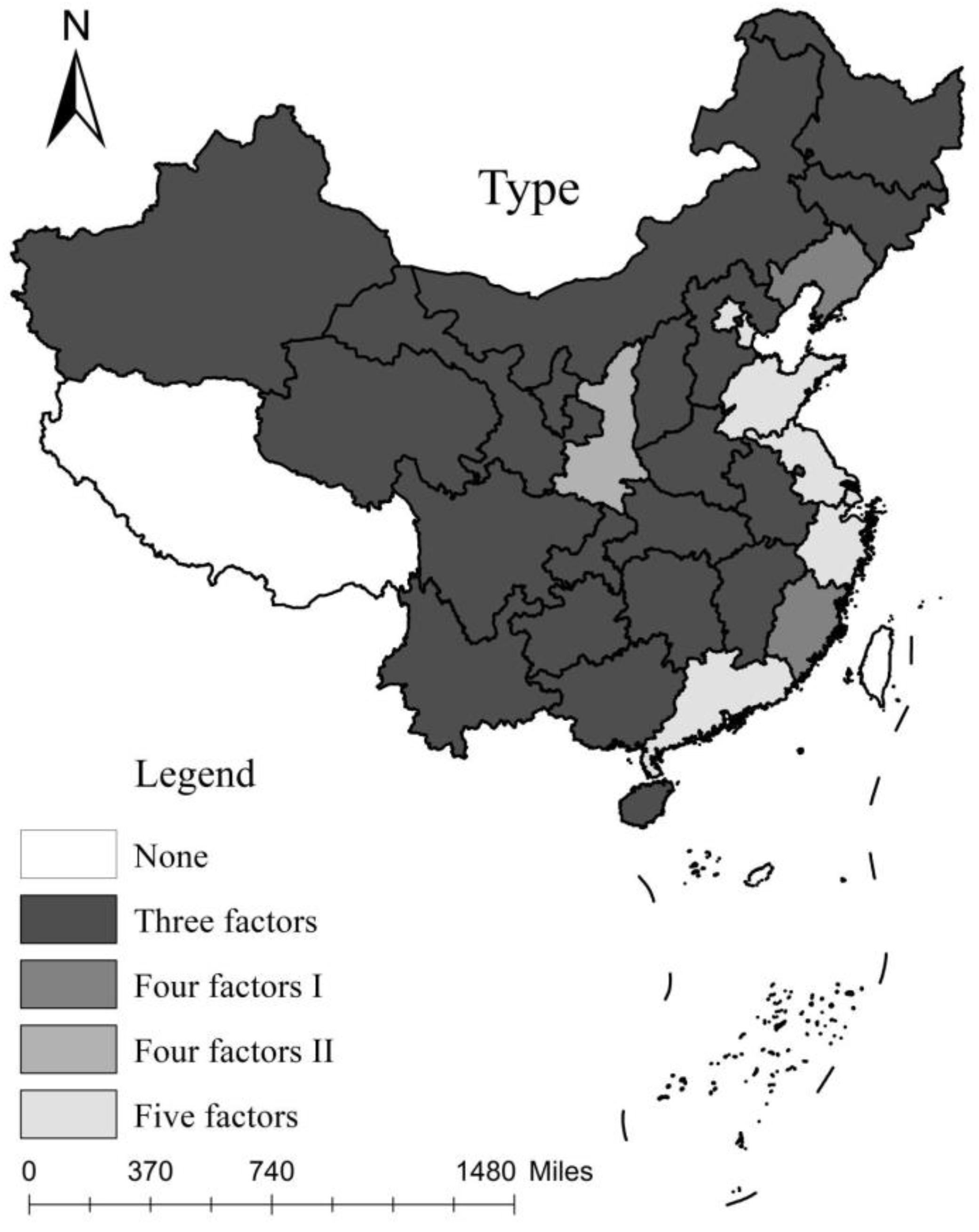1. Introduction
Over the course of 42 years, following the launch of reform and opening-up in 1978, China’s GDP grew from USD 0.06 trillion to USD 15.88 trillion (as of 2020), second only to the U.S., whose GDP increased to USD 20.89 trillion over the same period, making China the world’s second-largest economy. The gap between China and the U.S. is gradually narrowing. However, alongside rapid economic growth and the undeniably remarkable achievements it has made, China has encountered many problems in resource utilization and social management, such as energy shortages, land pollution, water resource destruction, regional development imbalances, and income gaps [
1,
2,
3]. According to a research report from the World Bank [
4], as the world’s largest emitter of sulfur dioxide (SO
2) and carbon dioxide (CO
2), China has 16 of the 20 most polluted cities in the world; 58% of China’s cities have an average annual PM10 concentration of more than 100 μg/m
3, and only 1% of China’s urban population lives in areas with an average annual PM10 concentration of less than 40 μg/m
3. Furthermore, 54% of the water in China’s seven major water systems is not suitable for human use. As early as 2003, the health costs caused by air pollution accounted for 1.16–3.8% of the GDP in that year [
4]. At the same time, agricultural nonpoint-source pollution continues to expand, with the pesticide adhesion rate only reaching 10~20%; the remaining 80~90% is lost in soil, water, and air. Meanwhile, the agricultural film residue rate is more than 42% [
5]. A report by the Global Environmental Performance Index in 2020 showed that China was ranked 120th out of 180 countries, with 37.3 points, indicating that China’s current economic development, reliant on high-energy consumption and high input, has become a major constraint for the sustainable development of the country’s social economy [
6,
7]. China’s achievements in economic growth and social progress have been impressive, but they have come at a heavy cost in terms of resources, the environment and even the widening gap between rich and poor. The negative effects brought about by economic development have already been recognized by China and many other countries. The 2030 Agenda for Sustainable Development released and implemented by the United Nations provides clear and specific guidance for countries around the world in the face of increasingly serious natural resource depletion, ecological and environmental damage crises and downward pressure on economic growth, thereby making resource conservation and environmentally friendly economic growth the common trends of global development. In the face of development difficulties, the Chinese government has made continuous efforts, including putting forward a series of ideas and measures such as “scientific outlook on development”, “building a resource-saving and environment-friendly society” and “high-quality development”, trying to transform China’s economy from high-speed growth to a green, low-carbon and circular economic system [
8]. At the same time, many scholars have put forward different views and suggestions on the transformation of China’s economic model. For example, Zhou and others [
9] proposed that in the process of industrial development and transformation, western China should continue to strengthen the development of environmental protection technologies, while the eastern region should encourage energy-saving innovative technologies; Hussain [
10] and other scholars believed that the Chinese government should continue to maintain GDP growth to effectively combat environmental degradation. It is necessary to reconsider policies related to population development, to reduce the environmental pressure caused by carbon dioxide emissions and limit China’s ecological footprint. A change in economic model, based on the pursuit of quality instead of quantity, can help China’s economy adapt to the new changes of the global social and economic situation, while effectively building harmonious coexistence between man and nature [
4,
5,
11].To promote the harmonious development of the economy and the environment, decision-making concepts have successively emerged including ecological civilization construction, high-quality economic development and new development patterns, which systematically and scientifically expound the importance and necessity of coordinated development in society, the economy and the environment [
11]. As the core dimension of China’s sustainable social and economic development, high-quality economic development continues, and has adopted the concept of sustainable development, replacing traditional development models by optimizing economic structure, transforming growth drivers and enhancing innovation capacity, etc. [
11,
12,
13]. High quality economic development is a process of upgrading from economic development focusing on “quantity” to “quality”. Its essence is quality and efficiency. Feng [
14], Guan [
15], Miao [
16], and other scholars have defined high-quality economic development as the realization of high-quality development at three different levels of industry. The quality of factor input has gradually become the cornerstone of high-quality development across the whole economy, supporting the iterative upgrading of new technologies, processes, and products. This includes the supply quality not only of environmental resources such as capital, land, and the environment, but also, for example, within universities in terms of the supply quality of innovative subjects such as research institutions and enterprises. However, the high-quality development of industry is mainly realized through industrial innovation and innovative industry. Industrial innovation is the process of introducing scientific and technological achievements into traditional industries, and promoting the transformation and upgrading of traditional industries through efficient technology transfer activities. Innovative industry is the process of incubating new technologies into new products, enterprises and models, and promoting the emergence of new industries, and formats. Realizing high-quality regional development is a process of factor endowment to collaborative innovation through innovative cooperation, industrial integration, and coordinated development, so that the achievements of high-quality development can be shared by the people, meet the people’s growing needs for a better life, and realize balanced, efficient, green and sustainable development across regions. This new model is in essence a methodology to solve the problem of unbalanced development within the economy, the environment and access to resources in China [
12]. It expands the breadth of solutions to the problems of resource and environmental sustainability, from the ecological environmental domain to areas of human development and social economy [
12,
13,
17]. What is the current situation of high-quality economic development in China’s regions? What are its evolutionary characteristics? Which factors play an important role in driving and influencing that development? Research on these issues will help clarify the arrangement and understand the pros and cons of high-quality economic development in provinces, providing important theoretical significance and practical value for the management and promotion of the sustainable development of China’s social economy.
After the emergence of classical and neoclassical economics, the majority of studies have analyzed only economic growth itself, from the perspective of a single factor or all factors, without involving the coordinated development of society, humanity, resources and the environment [
18,
19]. Since the 20th century, academics have gradually expanded the study from economic growth to the co-development of economy and quality, due to increasingly prominent development contradictions of various kinds. At the same time, as a developing country, China’s extensive economic growth with worsening side-effects in recent years has led an increasing number of experts and scholars to focus from multiple perspectives on how China’s economy should transform from high-speed to high-quality growth, mainly regarding the significance and evaluation of high-quality economic development [
19,
20,
21]. From the aspects of the significance of high-quality economic development, Liu [
22], Li [
23], Zhao [
24], Liu [
25], and other experts and scholars have analyzed all-factor productivity, economic growth, the philosophy of dialectical unification, financial asset allocation and local debt. Cosimo Magazzino [
26] probed into the features of China’s economic growth from the perspective of transportation infrastructure. American scholar Thomas redefined the meaning of economic quality growth from the perspective of social capital, natural capital and social welfare [
27]. Zhou [
9] has discussed the U-shaped relationship between technological innovation and China’s economic growth. Zeeshan Khan [
28] explored the relationship between natural resource endowment, technological innovation, human capital and financial development, taking China as an example. Researchers such as Mlachila [
29] and Martinez [
30], from the point of view of developing countries, have defined high-quality economic development as high-growth, sustainable and socially friendly development. From the perspective of the study of evaluation systems of high-quality economic development, Shi [
31] constructed an index system for assessing China’s provincial economic development according to six aspects: intensity, stability, rationalization, extroversion, human capital and ecological capital. Hu [
32] built a high-quality economic evaluation model based on the spatial Durbin model, which included five dimensions: economic structure, science technology, people’s livelihood, the environment and opening to the outside world. Song [
33] analyzed and compared the gap in economic development quality between China and other developed countries according to three dimensions: competition, people’s livelihood and ecology. Zhan [
34], constructed a comprehensive evaluation system to evaluate and measure the high-quality development of China’s regional economy, based on the “five development concepts”.
Although the existing literature of high reference value has studied the high-quality economy from various perspectives, there are some issues that still need to be discussed in depth.
First, through the exploration and research of different perspectives in “growth and development”, “economic growth and economic development”, and “quality of economic growth and economic development”, academic circles at home and abroad have further deepened understanding such issues as “what development is” and, “how to develop”. Through a review of relevant literature, this paper summarizes development as the improvement of economic structure, quality, efficiency and concept, while maintaining smooth operation of the economy, so as to achieve the goal of harmony between man and nature, improve living standards and quality, and accomplish all-round development of man [
13]. The concept of high-quality economic development, based especially on “innovation, coordination, greenness, sharing and opening-up”, is the logical route and the only way to build a comprehensive and sustainable development system in China to maintain coordinated development with the three pillars of society, economy and environment [
34]. Applying these five development concepts [
35] to evaluate China’s high-quality economic development will help clarify the “can do” and “what to do” problems in the process of practical development in the areas of resource utilization, environmental protection and economic growth, and also the internal interactions between each subsystem. This will be conducive to national and local governments’ understanding of the level of social and economic development in various stages and regions. It can provide a certain theoretical basis and reference value for the planning and design services of relevant public departments, enabling administrators to better improve the reliability of schemes and maximize benefits [
19,
23].
Second, from the perspective of the index weight measurement of high-quality economic development, the complexity and diversity of index weight have previously been ignored or considered with only one calculation method; in this case, the scientificity and comparability of index weight determination need to be optimized and improved. Economic development is a dynamic comprehensive system and closely related to the external environment [
3,
13,
36]. Although some scholars have studied high-quality economic development from various perspectives, the academic circle has not paid enough attention to its causal relationship with time and corresponding relationship with space. In recent years, remote sensing and spatial measurement software, such as the GEOGRAPHIC information system (Arcgis 10.2 ESRI (Environmental Systems Research Institute, Inc.) Redlands, CA, USA), have been widely used in regional evaluation. These technical tools can exert unique visual effects on plane base-maps by searching, storing, processing and analyzing geospatial data, and are closely integrated with geographic analysis tools, which has opened up a new way for people to analyze and address problems [
37]. The introduction of these technologies can provide powerful scientific support for the evaluation of high-quality economic development and the formulation of management policies.
Finally, the introduction and application of the LSE model can reveal not only the influencing factors behind regional differences of high-quality economic development and the reasons for these, but also help to formulate accurately relevant development plans by recognizing the mutual relationships inside the internal system. It can promote social and economic development, and the maximum protection and utilization of natural resources, providing data, analytical tools and new research thinking for relevant institutions and planners. The model can help find the most effective measures to achieve comprehensive sustainable development of the population, society, economy, resources and environment in each region [
38,
39].
In summation, based on reference to the evaluation system of high-quality economic development worldwide, this paper identifies and divides the subsystems of high-quality economic development [
2,
34,
40,
41], selects indicators representing the level of high-quality economic growth according to the principle of order parameters, and establishes an evaluation index system at the development level. This article comprehensively analyzes temporal and spatial variation characteristics and influencing factors of China’s high-quality economic development during the study period, using AHP, kernel density estimation and minimum variance, based on data from 30 regions (excluding Hong Kong, Macao, Taiwan, and Tibet) from 2004 to 2019. The research results are intended to reveal the current situation and problems facing high-quality development of China’s economy, and provide a theoretical reference for the formulation of strategies for the sustainable development of the social economy in different regions.
5. Conclusions and Policy Suggestions
5.1. Discussion
First, on the basis of previous studies, an evaluation index system of China’s high-quality economic development was constructed by adjusting certain indicators according to the actual economic situation of China’s provinces and regions. This study measured and calculated the development level of 30 provinces and regions in China from 2004 to 2019. The results showed scores between 0.167 and 0.540, and the overall level fluctuated year by year but presented a steady growth trend, indicative of a significant improvement in China’s high-quality economic development.
Second, the temporal evolution trend and spatial clustering analysis in this paper revealed that temporal evolution showed a trend of polarizing among provinces and regions. Although the polarization was alleviated with the passage of time, the development situation was very severe. The clustering analysis showed a spatial aggregation phenomenon in that the degree of high-quality economic development in eastern and eastern coastal regions was obviously better than that in other administrative regions, and the degree of development could be divided into four categories: strong, medium, weak and very weak. The evaluation index system and research method used in this paper focused on comparison of high-quality economic development in different regions, rather than the absolute value for each region, but they can reflect the general trend and pave the way for further evaluation of high-quality economic development in individual regions.
Third, the LSE method was adopted to calculate and analyze the contribution rate of five factors, namely innovation, coordination, greenness, sharing and opening-up, in the high-quality development of the provincial economy. The results are divided into four contribution types: three-factors type, four-factors type I, four-factors type II, and five factors type. The purpose of this was to reveal the contribution factors and spatial distribution laws of different contribution types, and to provide necessary theoretical reference for relevant departments to implement high-quality economic development in accordance with local conditions.
5.2. Policy Suggestions
Overall, with the existence of apparent regional discrepancy, the overall level of high-quality economic development was relatively low in the 30 provinces. Problems encountered in the central and western regions include an unreasonable industrial structure, a low level of social and economic development, inefficient management of high-quality economic development by governments, insufficient capital investment, and weak awareness of high-quality development among residents. In the future, the Chinese government should take the “five development concepts” as the basis to promote effectively the implementation of innovation-driven strategy, and release the dividend of technological innovation, so as to provide strong support for China’s long-term economic growth.
(1) Green development will continue to be pursued, to make the economy greener, promote green production methods, fuel the upgrading of green industries, and form new economic growth points. Governments should legislate to give priority to ecology and focus on commerce and trade circulation, e-commerce and other modern service industries, vigorously expanding the development space for green industry. Governments need to facilitate to the greatest possible degree the introduction of foreign capital and technology, to cultivate more brands of green products increasing their green value, to eliminate trade barriers, and to promote regional green trade.
(2) Provinces and regions with high levels of development should devote great efforts to optimizing their industrial structures, increasing investment in scientific and technological innovation and continuously raising awareness of high-quality economic development within government at all levels. It is of necessity to constantly increase financial support for environmental protection and investment in environmental pollution control, and to improve the mechanism for managing the coordinated development of the ecological environment and the economy. Moreover, there is an urgent need to transform and upgrade the traditional manufacturing industry by taking advantage of location, talent introduction and high-tech industry development. In the meantime, economically developed areas should play a distributive role in integrating superior resources and driving the development of less advanced areas.
(3) Moderately developed areas need to improve the ecological environment as well as the quality of life of their residents. They must rationally plan and use water, land and other natural resources, and enhance the level of agricultural and industrial modernization. Underdeveloped regions should improve the product structure of their primary and secondary industries and enhance the competitiveness of these sectors. Enterprises in the primary and secondary industries should actively implement the development mode of high production capacity and low consumption. The government should play a leading role, especially in the aspect of policy and funding support for expanding capital investment and infrastructure construction, increasing the all-resident per capita income and narrowing the proportional gap between urban and rural income.









